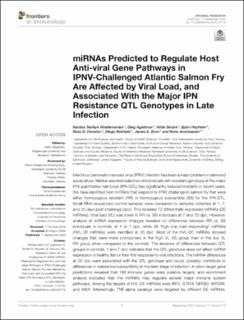| dc.description.abstract | Infectious pancreatic necrosis virus (IPNV) infection has been a major problem in salmonid aquaculture. Marker-assisted selection of individuals with resistant genotype at the major IPN quantitative trait locus (IPN-QTL) has significantly reduced mortality in recent years. We have identified host miRNAs that respond to IPNV challenge in salmon fry that were either homozygous resistant (RR) or homozygous susceptible (SS) for the IPN-QTL. Small RNA-sequenced control samples were compared to samples collected at 1, 7, and 20 days post challenge (dpc). This revealed 72 differentially expressed miRNAs (DE miRNAs). Viral load (VL) was lower in RR vs. SS individuals at 7 and 20 dpc. However, analysis of miRNA expression changes revealed no differences between RR vs. SS individuals in controls, at 1 or 7 dpc, while 38 “high viral load responding” miRNAs (HVL-DE miRNAs) were identified at 20 dpc. Most of the HVL-DE miRNAs showed changes that were more pronounced in the high VL SS group than in the low VL RR group when compared to the controls. The absence of differences between QTL groups in controls, 1 and 7 dpc indicates that the QTL genotype does not affect miRNA expression in healthy fish or their first response to viral infections. The miRNA differences at 20 dpc were associated with the QTL genotype and could, possibly, contribute to differences in resistance/susceptibility at the later stage of infection. In silico target gene predictions revealed that 180 immune genes were putative targets, and enrichment analysis indicated that the miRNAs may regulate several major immune system pathways. Among the targets of HVL-DE miRNAs were IRF3, STAT4, NFKB2, MYD88, and IKKA. Interestingly, TNF-alpha paralogs were targeted by different DE miRNAs. Most DE miRNAs were from conserved miRNA families that respond to viral infections in teleost (e.g., miR-21, miR-146, miR-181, miR-192, miR-221, miR-462, miR-731, and miR-8159), while eight were species specific. The miRNAs showed dynamic temporal changes implying they would affect their target genes differently throughout disease progression. This shows that miRNAs are sensitive to VL and disease progression, and may act as fine-tuners of both immediate immune response activation and the later inflammatory processes. | en_US |

